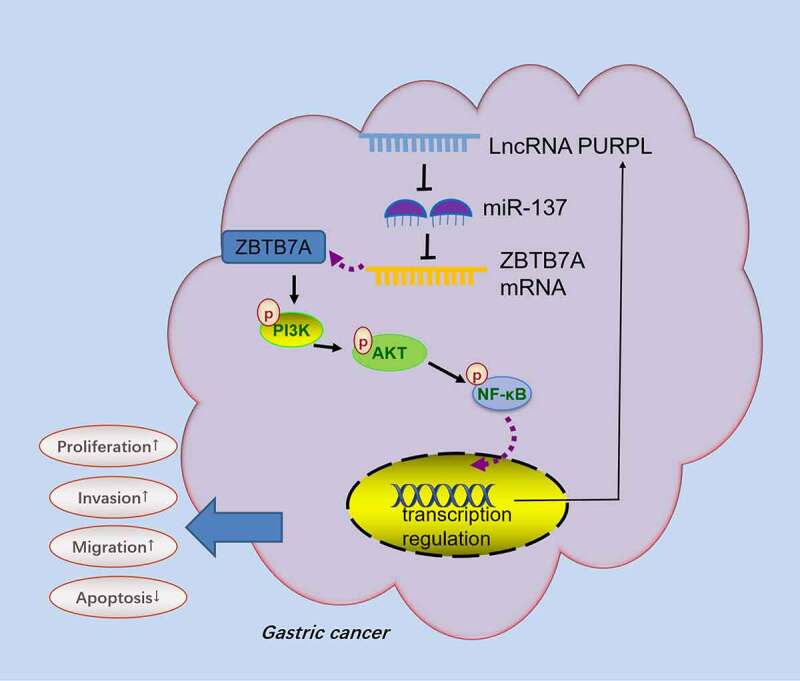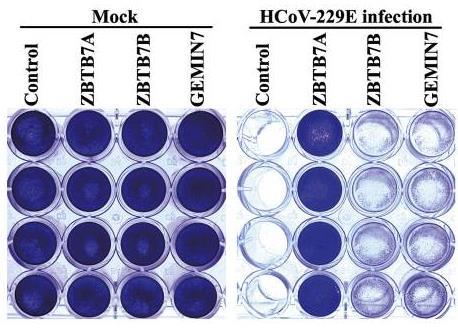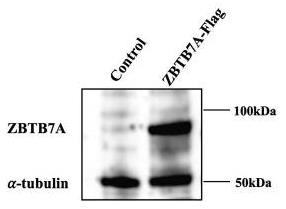ZBTB7A
-
Official Full Name
zinc finger and BTB domain containing 7A -
Overview
Zinc finger and BTB domain-containing protein 7A is a protein that in humans is encoded by the ZBTB7A gene. -
Synonyms
ZBTB7A;zinc finger and BTB domain containing 7A;ZBTB7, zinc finger and BTB domain containing 7;zinc finger and BTB domain-containing protein 7A;DKFZp547O146;FBI 1;LRF;lymphoma related factor;pokemon;HIV 1 inducer of short transcripts binding protein;ZNF857A;TIP21;zinc finger protein 857A;HIV-1 1st-binding protein 1;TTF-I-interacting peptide 21;factor binding IST protein 1;leukemia/lymphoma-related factor;POK erythroid myeloid ontogenic factor;HIV-1 inducer of short transcripts binding protein;POZ and Krueppel erythroid myeloid ontogenic factor;factor that binds to inducer of short transcripts protein 1;zinc finger and BTB domain containing 7A, HIV-1 inducer of short transcripts binding protein;FBI1;FBI-1;ZBTB7;MGC99631
Recombinant Proteins
- Human
- Mouse
- Chicken
- Rat
- E.coli
- Mammalian Cell
- HEK293T
- HEK293
- Mammalian cells
- His
- Non
- Myc&DDK
- His&Fc&Avi
- Flag
Background
What is ZBTB7A Protein?
ZBTB7A, also known as LRF or FBI-1, is a protein created by the ZBTB7A gene. It serves as a transcription factor, meaning it links to particular DNA sequences to manage gene activity. This protein contributes to processes like cell growth, development, and how cells deal with DNA damage. By controlling gene activation, ZBTB7A plays a significant role in how cells function normally and in various diseases.What is the Function of ZBTB7A Protein?
ZBTB7A protein plays a role as a transcription factor, meaning it helps control which genes are active in a cell. It's involved in a variety of processes like cell growth, differentiation, and response to DNA damage. ZBTB7A binds to DNA at specific sites, which can either block or encourage the reading of genes. This function is key for regulating normal cellular activities and can also impact the development of diseases, including certain cancers.ZBTB7A Related Signaling Pathway
ZBTB7A impacts several signaling pathways that are vital for cell growth and function. It helps suppress the Akt pathway, a key player in cell survival and growth. ZBTB7A also interacts with other molecules to affect apoptosis and cell metabolism. Additionally, it can adjust the NF-kB pathway, which plays a role in immune responses and inflammation. Through these interactions, ZBTB7A plays a critical role in managing cell activities and has links to diseases such as cancer.
Fig1. Schematic diagram of PURPL-miR-137-ZBTB7A/PI3K/AKT/NF-κB axis in GC development. (Zhonghua Cheng, 2022)
ZBTB7A Related Diseases
ZBTB7A is linked to several diseases, primarily certain types of cancer. It's known to be involved in the development and progression of cancers like lymphoma and leukemia. By affecting gene expression, ZBTB7A can promote cancer cell growth and survival. It also has been studied in the context of solid tumors, where its activity might influence tumor growth or response to treatments. Understanding ZBTB7A's role in these diseases helps in exploring new therapeutic approaches that could target its function to inhibit cancer progression.Bioapplications of ZBTB7A
ZBTB7A's role in gene regulation makes it a target in cancer research. Scientists are exploring how modifying its activity could help treat cancers, given its influence on tumor growth and survival. By targeting ZBTB7A, new therapies could potentially disrupt cancer progression. Additionally, its involvement in gene expression offers insights into developing drugs that can adjust these pathways, providing a potential strategy for cancer intervention and other diseases linked to this protein.Case Study
Case Study 1: Zhu X. et al. Cell Rep. 2022
Researchers found that when cells get infected by human coronaviruses (HCoVs), they usually die. However, they noticed that the gene activity in some cells might lead to different outcomes. By using a CRISPR screen with HCoV-229E, they identified that the transcription factor ZBTB7A helps cells survive after infection. Rather than stopping the virus, ZBTB7A allows the virus to peacefully coexist with the cell in a stable state. They also discovered that managing oxidative stress is key to helping cells survive during HCoV-229E infection. This shows that a cell's gene expression before infection can heavily influence its fate.-
 Fig1. Crystal violet staining of transduced Huh7 cells after infection.
Fig1. Crystal violet staining of transduced Huh7 cells after infection. -
 Fig2. ZBTB7A-FLAG expression (and tubulin loading control) from transduced Huh7 cells.
Fig2. ZBTB7A-FLAG expression (and tubulin loading control) from transduced Huh7 cells.
Case Study 2: Yang Y. et al. Cell Rep. 2021
High fetal globin protects against sickle cell and β-thalassemia. Researchers identified BCL11A and ZBTB7A proteins binding at key spots on globin promoters. By studying ZBTB7A's binding structure, mainly with C:G base pairs, they found changes in DNA that can weaken this binding. These insights highlight ZBTB7A's role in controlling globin and guide gene editing approaches to increase fetal globin, offering potential treatments.-
 Fig3. FP assay of ZBTB7A ZF fragments expressed in E. coli with and without N- and C-terminal additions.
Fig3. FP assay of ZBTB7A ZF fragments expressed in E. coli with and without N- and C-terminal additions. -
 Fig4. An EMSA showing the effect on ZBTB7A (using a FLAG-tagged residues 370–500) binding to DNA.
Fig4. An EMSA showing the effect on ZBTB7A (using a FLAG-tagged residues 370–500) binding to DNA.
Quality Guarantee
High Purity
-
.jpg) Fig1. SDS-PAGE (ZBTB7A-2914H)
Fig1. SDS-PAGE (ZBTB7A-2914H)
Involved Pathway
ZBTB7A involved in several pathways and played different roles in them. We selected most pathways ZBTB7A participated on our site, such as , which may be useful for your reference. Also, other proteins which involved in the same pathway with ZBTB7A were listed below. Creative BioMart supplied nearly all the proteins listed, you can search them on our site.
| Pathway Name | Pathway Related Protein |
|---|
-
 Fig1. Endoplasmic reticulum (ER) stress promotes the binding between ribosomal protein L5 (RPL5) and MDM2 protein, thus preventing MDM2-mediated ubiquitination and degradation of P53 protein. (Jie Tang, 2024)
Fig1. Endoplasmic reticulum (ER) stress promotes the binding between ribosomal protein L5 (RPL5) and MDM2 protein, thus preventing MDM2-mediated ubiquitination and degradation of P53 protein. (Jie Tang, 2024) -
 Fig2. The mechanism of U3/ZBTB7A/HK2 LDHA pathway promoting aerobic glycolysis and proliferation of IDH1WT GBM. (Weiwei Dong, 2023)
Fig2. The mechanism of U3/ZBTB7A/HK2 LDHA pathway promoting aerobic glycolysis and proliferation of IDH1WT GBM. (Weiwei Dong, 2023)
Protein Function
ZBTB7A has several biochemical functions, for example, DNA binding,RNA polymerase II core promoter proximal region sequence-specific DNA binding,histone acetyltransferase binding. Some of the functions are cooperated with other proteins, some of the functions could acted by ZBTB7A itself. We selected most functions ZBTB7A had, and list some proteins which have the same functions with ZBTB7A. You can find most of the proteins on our site.
| Function | Related Protein |
|---|---|
| RNA polymerase II core promoter proximal region sequence-specific DNA binding | HOXC11,FOSL1,ELK1,ZNF217,EBF1,POU2F2,POU1F1,ZNF664,FOXA2,NKX2 |
| transcriptional repressor activity, RNA polymerase II core promoter proximal region sequence-specific binding | NEUROG3,HES1,BACH1,NR2E1,NFIL3-2,KLF16,PROX1A,BHLHE40,MLXIPL,PYDC3 |
| DNA binding | HMGB3A,SOX6,CDAN1,H2AFX,HMGN1,NR4A2B,SOX15,SCML4,ZNF367,NRL |
| protein binding | NFATC3,LPAR1,PPIL1,MRAP2,BIRC5,USP12,XPO6,TBC1D10C,OFD1,WASF1 |
| histone acetyltransferase binding | ETS1,TRIP4,SP1,MTF1,TRIM68,GLI3,TAF7L,NR4A3,CEBPB,HIF1A |
| metal ion binding | KLF12A,IRGF4,FGD2,PPTC7A,ZNRF2B,KLF8,OLA1,RPS27A,ING5B,NRP2B |
Interacting Protein
ZBTB7A has direct interactions with proteins and molecules. Those interactions were detected by several methods such as yeast two hybrid, co-IP, pull-down and so on. We selected proteins and molecules interacted with ZBTB7A here. Most of them are supplied by our site. Hope this information will be useful for your research of ZBTB7A.
KHDRBS1;HOMEZ;HDAC1;ZMYND8;mdm2_human_probe
Resources
Related Services
Related Products
References


